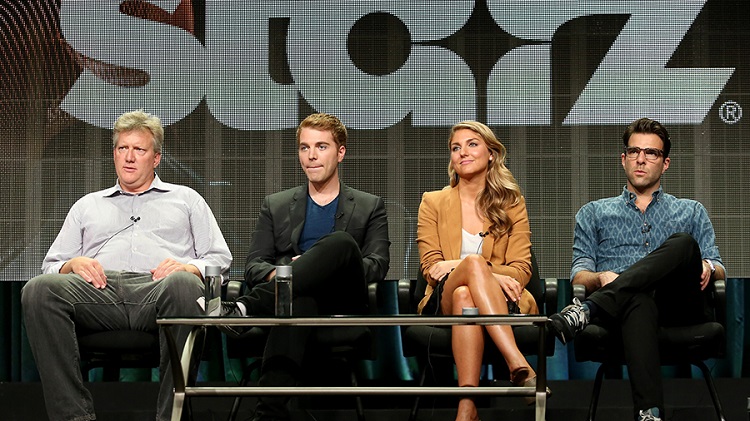‘The Chair’ wrapped up season 1 at the end of 2014 and there’s still no sign of a season 2 but it remains a great concept and filmmaking tool regardless. Following the show, producers Josh Shader and Chris Moore unearth some helpful tips for first-time director’s or writers.

‘The Chair’ was a reality TV program which played on the STARZ network. It followed two directors, Shane Dawson and Anna Martemucci, as they endeavoured to make their first feature film. The winner, based on a survey as to who made the better film, would receive a healthy $250,000; with which they might start their next feature film, or buy a flash car. The interesting thing about this show, which also included Zachary Quinto as a co-executive producer, is that both director’s were given an identical script and budget to work with. They also had to shoot in the same city. This made it particularly intriguing because it illuminated the question that many people have often posed, what do director’s actually do? It showed the wildly different directions a film can go, depending on who the mind is behind the film, even with an identical script. Director’s are the vision, they interpret the script and choose the best way to tell the story. A director can be the sole reason for a film’s success or failure. Dawson won the competition with his raunchy sex-joke fuelled comedy ‘Not Cool’.
Martemucci took a more tender, but still humerous approach with her film ‘Holidaysburg.’ You can tell it’s the same script but the movies are decidedly different in tone and the way the character’s are developed.
The show wasn’t without controversy. Many critics preferred Martemucci’s effort and believed it was simply Dawson’s very large following on YouTube and social media that got him over the line with the survey.
Chris Moore stated earlier this year he has plans for a second season, but doesn’t know when that will happen.
“It’s got to be new and different. …We’re looking for a different kind of movie. And I would like to have more money so the movies are a little bigger and get some real cast members. Everybody wants to be a part of it again and I have made a commitment to everybody in Pittsburgh who supported us, particularly Point Park University because it was very successful for their students, that I’ll be back.”
More recently, both he and fellow producer Josh Shader have given their thoughts to slashfilm on the mistakes first-time filmmakers make and how a filmmaker can improve.
[symple_heading style=”” title=”Passion” type=”h1″ font_size=”” text_align=”left” margin_top=”30″ margin_bottom=”30″ color=”undefined” icon_left=”” icon_right=””]Not having enough passion for your project is a surefire way to ruin your film. As a director you have to convince everyone else that this story is one worth telling, and to succeed in that you have to believe it yourself. If the passion isn’t there, the actors won’t feel it and the audience certainly won’t connect to it. Shader added that “Because someone gave me the money is a terrible reason to make a movie.”
[symple_heading style=”” title=”Collaboration” type=”h1″ font_size=”” text_align=”left” margin_top=”30″ margin_bottom=”30″ color=”undefined” icon_left=”” icon_right=””]The director is the captain, the boss, the CEO of a movie but filmmaking is an incredibly collaborative process and if you treat your team poorly or restrict their creative license too much, you’ll lose their dedication. A great director will inspire their crew to want to work for them, no matter what the pay or rewards are.
[symple_heading style=”” title=”Criticism” type=”h1″ font_size=”” text_align=”left” margin_top=”30″ margin_bottom=”30″ color=”undefined” icon_left=”” icon_right=””]Just because the director is the one making the final decisions, doesn’t mean every decision they make is the right one. A director must be open to constructive criticism from the professionals (hopefully) they are working with. Sometimes a new perspective is helpful.
[symple_heading style=”” title=”Flexibility” type=”h1″ font_size=”” text_align=”left” margin_top=”30″ margin_bottom=”30″ color=”undefined” icon_left=”” icon_right=””]“Putting yourself in a bubble may make the journey easier, but it will likely result in a worse film,” says Shader.
A director may think they know exactly where a film is going before they start filming but things can change as the process moves along. A good director won’t be afraid to reassess his/her initial thoughts and investigate if there is a better way to be doing things. Shader says a director needs to be agile with their thinking.
[symple_heading style=”” title=”The Medium” type=”h1″ font_size=”” text_align=”left” margin_top=”30″ margin_bottom=”30″ color=”undefined” icon_left=”” icon_right=””]“You have to be able to adapt and change to make it work on the day. And then, of course, you make it work on the day and you think it’s great, and the you get into post-production and you realize it’s not working. And you have to also then be able to change your vision.”
First-timers need to carefully consider whether their story is best told as a film, of if they just want to make it a film because that is the most exciting. Before you make your film, you must be certain a visual medium is the best way to showcase the story you want to tell.
These are all great lessons for any aspiring filmmaker or storyteller and let’s hope a Season 2 of the chair happens, because it’s a fascinating concept.







